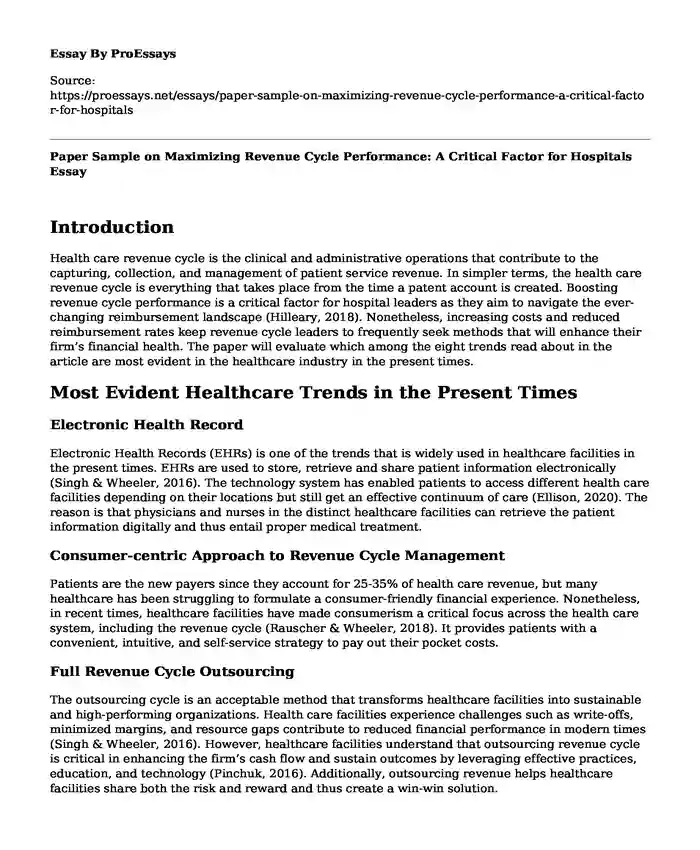Introduction
Health care revenue cycle is the clinical and administrative operations that contribute to the capturing, collection, and management of patient service revenue. In simpler terms, the health care revenue cycle is everything that takes place from the time a patent account is created. Boosting revenue cycle performance is a critical factor for hospital leaders as they aim to navigate the ever-changing reimbursement landscape (Hilleary, 2018). Nonetheless, increasing costs and reduced reimbursement rates keep revenue cycle leaders to frequently seek methods that will enhance their firm’s financial health. The paper will evaluate which among the eight trends read about in the article are most evident in the healthcare industry in the present times.
Most Evident Healthcare Trends in the Present Times
Electronic Health Record
Electronic Health Records (EHRs) is one of the trends that is widely used in healthcare facilities in the present times. EHRs are used to store, retrieve and share patient information electronically (Singh & Wheeler, 2016). The technology system has enabled patients to access different health care facilities depending on their locations but still get an effective continuum of care (Ellison, 2020). The reason is that physicians and nurses in the distinct healthcare facilities can retrieve the patient information digitally and thus entail proper medical treatment.
Consumer-centric Approach to Revenue Cycle Management
Patients are the new payers since they account for 25-35% of health care revenue, but many healthcare has been struggling to formulate a consumer-friendly financial experience. Nonetheless, in recent times, healthcare facilities have made consumerism a critical focus across the health care system, including the revenue cycle (Rauscher & Wheeler, 2018). It provides patients with a convenient, intuitive, and self-service strategy to pay out their pocket costs.
Full Revenue Cycle Outsourcing
The outsourcing cycle is an acceptable method that transforms healthcare facilities into sustainable and high-performing organizations. Health care facilities experience challenges such as write-offs, minimized margins, and resource gaps contribute to reduced financial performance in modern times (Singh & Wheeler, 2016). However, healthcare facilities understand that outsourcing revenue cycle is critical in enhancing the firm’s cash flow and sustain outcomes by leveraging effective practices, education, and technology (Pinchuk, 2016). Additionally, outsourcing revenue helps healthcare facilities share both the risk and reward and thus create a win-win solution.
Conclusion
Healthcare facilities aim at minimizing cost and still maintain patient quality by using the healthcare revenue cycle that would enable them to manage, capture and collect patient service revenue. However, there are trends such as the consumer-centric approach, outsourcing cycle, and the use of electronic health records that help minimize cost in treating patients but still guarantee quality services.
References
Ellison, S. (2020). Hospital revenue cycle trends to watch in 2019 — 8 thoughts: Shrinking reimbursement rates and increasing costs keep hospital and health system CFOs. https://www.beckershospitalreview.com/finance/hospital-revenue-cycle-trends-to-watch-in-2019-8-thoughts.html.
Hilleary, G. (2018). Practitioner application: Effective hospital revenue cycle management: is there a trade-off between the amount of patient revenue and the speed of revenue collection? Journal of Healthcare Management, 53(6), 405-406. https://doi.org/10.1097/00115514-200811000-00009
Pinchuk, S. (2016). Changing revenue management and marketing using a new customer life cycle system. Journal of Revenue and Pricing Management, 8(1), 109-111. https://doi.org/10.1057/rpm.2008.52
Rauscher, S., & Wheeler, J. (2008). Effective Hospital revenue cycle management: Is there a trade-off between the amount of patient revenue and the speed of revenue collection? Journal of Healthcare Management, 53(6), 392-404. https://doi.org/10.1097/00115514-200811000-00008
Singh, S., & Wheeler, J. (2016). Hospital financial management: What is the link between revenue cycle management, profitability, and not-for-profit hospitals’ ability to grow equity? Journal of Healthcare Management, 57(5), 325-341. https://doi.org/10.1097/00115514-201209000-00007
Cite this page
Paper Sample on Maximizing Revenue Cycle Performance: A Critical Factor for Hospitals. (2023, Sep 25). Retrieved from https://proessays.net/essays/paper-sample-on-maximizing-revenue-cycle-performance-a-critical-factor-for-hospitals
If you are the original author of this essay and no longer wish to have it published on the ProEssays website, please click below to request its removal:
- Medicine Essay Example: A Stroke Symptoms and Treatment
- Research Paper on HIV as a Condition Lacks Education in Dealing With Stigmatization Assumptions in the Society
- Contemporary Nursing and Issues Social Issues Paper Example
- Essay Sample on Management of the Centre for Diseases Control Organization (CDC)
- Article Analysis Essay on What is an RN?
- Role of Homeland Security Department in Managing Hurricane Sandy and Katrina
- Essay Example on Shining Hope: Jessica & Kennedy's Quest to Transform Kibera Slums







